Interview audio Laméca
Neil Clarke (2002)
Propos recueillis par Gustav Michaux-Vignes (Laméca) en décembre 2002 à Basse-Terre (Guadeloupe).
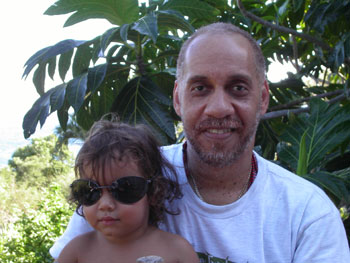
Neil Clarke (et Jali Michaux-Vignes) à Sainte-Anne en décembre 2002.
© Médiathèque Caraïbe (Laméca)
A propos de Neil Clarke et du contexte de l'interview
Percussionniste étatsunien (Brooklyn, New-York), il joue principalement des percussions afro-cubaines (conga, bongo, bata...) et africaines (djembé...). Il a été membre d'African Spirit, la formation de son compatriote le pianiste Randy Weston, invité par le Festival Echos de Liberté du Conseil Général en décembre 2002 en vue d'une rencontre avec la musique gwoka du trompettiste guadeloupéen Kafé.
Après 15 jours d'immersion dans l'univers gwoka (rencontre puis concert avec Kafé et ses musiciens, soirée léwòz à Viard Sainte-Rose, rencontre avec Bébé Rospart, Gérard Pomer, Georges Troupé, Jean-Marie Lurel, Joseph "Ti Bonm La" Kancel..., écoute du fonds discographique gwoka de la Médiathèque Caraïbe), Neil nous donne son sentiment sur cette musique.
Pour plus d'informations sur Neil Clarke >>>
Cette interview a été réalisé pour la rubrique "Le gwoka vu par... les musiciens" du dossier Laméca consacré au gwoka (édité sur lameca.org en 2001). Elle intègre le fonds de collecte de la mémoire orale des musiques traditionnelles de la Guadeloupe (fonds Palé pou sonjé), constitué par Laméca depuis 2005.
Interview transcrite et traduite en français
Avant que je vienne ici [en Guadeloupe], je n'avais aucune idée du gwoka. Peut-être que si j'avais vu le CD avec David Murray [album Creole, Justin Time, 1998] ou autre chose, j'aurais pu connaître.
Mais je ne savais rien du gwoka et, en fait, je ne connaissais même pas ce nom avant que j'arrive et que je pose des questions à Luc [Michaux-Vignes] sur la musique traditionnelle d'ici.
J'ai cherché sur Internet des informations sur la culture traditionnelle de Guadeloupe, et j'ai trouvé des choses sur le zouk et un peu sur la biguine, mais rien sur le gwoka.
Peut-être que ma recherche n'était pas assez fouillée ou pas assez large, mais j'en sais un peu plus que le simple touriste. Si je n'ai rien trouvé, ce serait difficile pour le simple touriste de trouver quelque chose, parce qu'il n'y a rien.
Quand je suis arrivé, Luc [Michaux-Vignes] m'a parlé du gwoka, il m'a parlé des tambours traditionnels, il m'a apporté quelques explications, mais je n'avais pas d'idée de ce que c'était.
En commençant à découvrir des choses sur le gwoka, la première des choses que j'ai compris est qu'il s'agissait d'un style de musique, et que ce style de musique tirait son nom d'un tambour appelé gwoka. Je savais donc qu'il y avait une musique gwoka, qu'il y avait un tambour gwoka, sans autre précision.
Ma première expérience du gwoka a été la démonstration de Kafé. Kafé a expliqué les 7 rythmes en jouant le boula, mais sans le makè. Sa démonstration n'incluait pas la chanson ni la danse. Pour moi, c'était incomplet.
Mais, parce que je suis intéressé, parce que je suis percussionniste, parce que j'ai entrepris des recherches pendant 30 ans, j'avais conscience que c'était incomplet.
Si quelqu'un de Guadeloupe vous fait une démonstration de gwoka et que tout ce qu'il donne c'est le rythme du boula, vous pouvez penser que le gwoka se limite à ça. Et vous n'avez alors aucune idée de la complexité et de la profondeur de la tradition, parce que vous n'avez pas tous les éléments.
C'est comme de dire que le jazz c'est juste [il chante un rythme basique] et rien de plus. Il vous faut la base, la structure harmonique... le jazz c'est tout ça.
Pour avoir vraiment une idée, disons, un individu moyen qui vient en Guadeloupe peut ne pas être intéressé au "gwoka folklorique", au "gwoka traditionnel". Mais il peut s'intéresser au "gwoka moderne". Mais pour pouvoir vraiment comprendre le "gwoka moderne", ce serait pas mal d'avoir la compréhension du "gwoka traditionnel", de façon à voir d'où cela vient.
En devenant plus conscient de ce qu'est le gwoka, ce qui me stupéfait, ce qui me stupéfait vraiment, c'est la richesse de cette tradition avec les percussions, avec la danse, avec les chansons, avec la structure de la mélodie, avec l'interaction entre le danseur et le tambour makè...
Qu'il y ait une tradition aussi riche et que je ne la connaisse pas !
J'ai voyagé dans le monde entier. Les percussionnistes connaissent la bomba, ils connaissent la plena, ils connaissent la samba, ils connaissent la batucada, ils connaissent le merengue... ils connaissent tous ces rythmes différents de la Caraïbe... Et le gwoka reste un grand secret, un grand mystère. Pas même un mystère, parce que peut-être que vous avez entendu parler du gwoka, mais que vous ne connaissez rien à son sujet. Mais au moins vous savez qu'il y a là quelque chose à découvrir.
Je devais découvrir ce qu'étaient ces 7 rythmes, ces 9 rythmes, avec des noms différents, certains reflétant des noms d'Afrique.
J'ai étudié les percussions ouest-africaines, beaucoup d'ensembles de tambours, de styles et de traditions du Mali, de Guinée, du Sénégal, du Nigeria, du Ghana, de Côte d'Ivoire.
Alors quand je vois cela, qu'il y a quelque chose en Guadeloupe où vous avez un type particulier de tambour, qui est fait d'une façon particulière, qui est joué avec une technique particulière, qu'il y a des notes particulières, qu'il y a une façon particulière de jouer en relation au danseur, qu'il y a une interaction particulière entre le tambour et la danse, qu'il y a des maîtres reconnus, qu'il y a différents styles pour différentes régions de l'île... Tout cela me dit qu'il s'agit de quelque chose de vraiment significatif.
Ce n'est pas seulement quelque chose pour lequel des gens se rassemblent et jouent la première chose qui leur passe par la tête.
Il y a des maîtres, il y a des styles, il y a des traditions. Cela me dit qu'il s'agit q'un genre complet. Et je pense que la majorité des gens n'a pas l'occasion de le comprendre à ce niveau. Je pense que la seule raison pour laquelle je commence à le comprendre à ce niveau pendant les 15 jours que j'ai passé ici c'est parce que, premièrement, j'ai eu l'expérience d'étudier et de faire des recherches sur les traditions de tambours et, deuxièmement, parce que j'ai pris l'initiative, j'ai eu la motivation de chercher et de poser des questions pour trouver.
Même les gens de mon groupe [African Project] avec lequel je joue, ils ne le comprennent pas de la façon dont je le comprends, parce qu'ils n'ont pas pris le temps de chercher et de poser des questions.
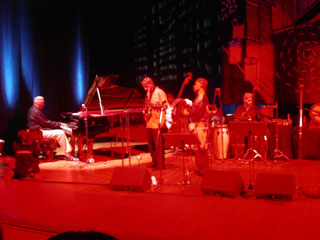
Randy Weston (à gauche, au piano) et son groupe African Spirit à l'Artchipel (Basse-Terre) en décembre 2002. Neil Clarke est aux percussions (à droite).
© Médiathèque Caraïbe (Laméca)
J'ai le sentiment d'avoir seulement effleuré la surface, parce que ce que je pense du gwoka en tant que musique traditionnelle de Guadeloupe, c'est que c'est une expression de la vie, de l'histoire, de la tradition, du sentiment. Toutes ces choses, la façon dont ils dansent, les phrases...
Je connais les phrasés d'Afrique. Quand on étudie les percussions traditionnelles africaines et les variations de styles, très souvent, il y a une relation direct entre le langage parlé et la cadence et la façon dont les phrases sont jouées sur le tambour. Si vous écoutez des percussions africaines d'une région particulière et que vous faites la comparaison d'une variation, très souvent, il y a une relation directe entre la cadence et la façon dont les gens parlent, la structure rythmique des phrases. Souvent le tambour agit comme un succédané de la parole, comme dans le bata. Traditionnellement, le bata c'est des phrases parlés.
Si vous discutez avec des joueurs de djembé de certaines régions de la Guinée, du Mali ou de la Côte d'Ivoire, ils parlent quand ils jouent les phrases qu'ils jouent. En matière de débit, en matière de cadence, la façon dont ils parlent reflète la façon dont ils jouent ; la façon dont ils jouent reflète la façon dont ils parlent.
C'est pourquoi souvent si vous jouez de la rumba et que vous ne savez pas parler espagnol et que vous ne comprenez pas la façon dont les gens parlent, vous n'allez pas vraiment comprendre la phrase.
Le soir où nous avons été au léwòz [Viard, Sainte-Rose], quand j'ai joué avec Ti bonm-la [Joseph Kancel], il jouait, je comprenais tout ce qu'il jouait, mais pour trouver la façon de jouer de la manière dont il jouait il aurait fallu que je pense en créole. Parce que sa manière de jouer est créole ; ma manière de jouer est Brooklyn.
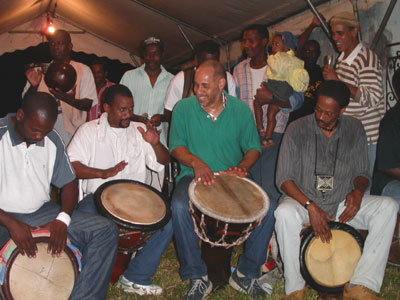
Neil Clarke (centre droit, au tambour makè de Gérard Pomer), Joseph "Ti bonm-la" Kancel (centre gauche, au tambour makè), Joel Jean (à droite, au tambour boula), Jean-Marie Lurel (debout, à droite, au chant lead) à une soirée léwòz à Viard Sainte-Rose en décembre 2002.
© Médiathèque Caraïbe (Laméca)
Je serais capable de jouer comme ça, mais cela prendrait du temps. Et si j'apprends à parler créole, si j'apprends l'état d'esprit, si j'apprends le sentiment, si j'apprends le feeling, alors je pourrais jouer le marqueur, je n'en doute pas.
Comme on dit, si on veut apprendre une langue, vous devez trouvez une petite amie du pays, par ce que vous devez l'apprendre de façon organique.
Comme le disait Georges Troupé, comprendre c'est étudier scientifiquement. Pour le faire, vous devez le faire organiquement. Vous devez le faire parce que vous le ressentez.
Un professeur peut écrire au tableau la partition, les différents rythmes du gwoka, n'importe quelle musique étudiée ; n'importe qui capable de lire la musique comprendra, mais ça ne veut pas dire qu'il peut la jouer. Vous voyez des gens qui étudient et qui comprennent, qui jouent, mais ce n'est pas vivant. Pour que cela soit vivant, il faut le ressentir, en faire l'expérience.
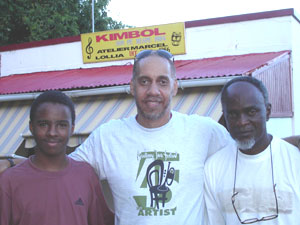
Neil Clarke en décembre 2002 à l'école de musique Kimbòl (Valet, Sainte-Anne) de Georges Troupé (à droite), avec Arnaud Dolmen (à gauche, batteur et percussionniste guadeloupéen).
© Médiathèque Caraïbe (Laméca)
Avec le gwoka, je commence juste, c'est pour cela que c'est important pour moi de commencer par le "gwoka traditionnel", de commencer par le léwòz, parce que c'est la racine. C'est de là que tout vient.
Du gwoka moderne au zouk, tout a commencé par le léwòz, tout a commencé par le padjanbel, par le mendé, par le graj, par le tumblak...
Ainsi, de façon à comprendre, en me construisant une compréhension de la musique du boula, de la musique du léwòz, maintenant que je me dirige vers le gwoka moderne, je comprends d'où ça vient. Mais si je ne comprends pas que la base est le boula, je peux prendre des liberté dans l'improvisation, en ne sachant pas que cela doit aller de pair, de la même façon que la clave et le tumbao dans la musique cubaine. Parce que dans la musique cubaine la base qui est jouée vient vraiment du tumbao. Les gens entendent la base et disent oui, c'est super, sans se rendre compte que cela vient du tambour.
On construit sa compréhension en partant de l'origine. J'ai discuté avec Bébé [Pierre-Jean Rospart], j'ai discuté avec Gérard [Pomer], j'ai discuté avec Ti bonm-la [Joseph Kancel]… différents styles, différentes saveurs… Je suis sûr qu'en restant plus longtemps, j'aurais compris.
Maintenant que j'en ai l'occasion, ma prochaine étape serait d'écouter le gwoka moderne, ce que je n'ai pas encore commencé à faire. Je ne peux même pas dire quelle est l'expression de la musique populaire en Guadeloupe, parce que je ne suis pas encore arrivé à ce stade. Je peux l'apprécier, je peux y prendre plaisir, mais pour pouvoir la jouer, je dois d'abord comprendre.
Avec le gwoka, cela m'étonne aussi qu'il n'y ait plus la connaissance de la signification des rythmes et de l'origine des rythmes. Cela m'étonne vraiment que les rythmes aient survécu de la façon particulière dont ils ont survécu, sans avoir plus que cela de significations qui y soient attachées : un ordre particulier ou une signification culturelle.
Car évidemment les rythmes africains étaient traditionnellement utilisé pour des usages particuliers : rythmes de travail, rythmes de prière, rythmes de célébration, rythmes religieux…
Je trouve intéressant que le corps du matériel rythmique ait survécu sans la signification particulière pour les différents rythmes, sans l'usage particulier des rythmes.
Je pense que c'est important parce que quand j'ai assisté au cours de Bébé [Pierre-Jean Rospart], Bébé expliquait aux danseurs qu'il y a certains mouvements qui sont appropriés et acceptables et certains mouvements qui ne sont pas appropriés et pas acceptables. Une des choses qu'il a dite est que les filles ne doivent pas lever les jambes trop haut. Une autre chose qu'il a dite est que les genoux ne doivent pas toucher le sol. Encore une autre chose qu'il a dite est qu'il ne doit pas y avoir d'arrêt dans le mouvement.
Si les gens ne comprennent pas la musique, il n'y a pas de raisons qu'ils ne fassent pas des choses inappropriées.
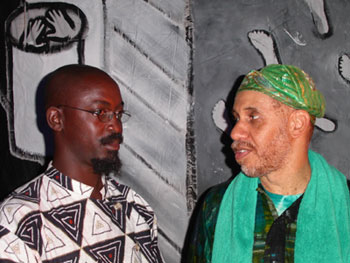
Pierre-Jean "Bébé" Rospart (à gauche) et Neil Clarke (à droite) à l'Artchipel (Basse-Terre) en décembre 2002.
© Médiathèque Caraïbe (Laméca)
Avec les générations qui passent, et avec plus personne qui comprenne la musique pour les empêcher de faire des choses inappropriées, alors la tradition va disparaître.
J'ai demandé à Gérard Pomer ce qu'il en pensait, et je lui ai demandé cela en me rappelant ce que disait Bébé Rospart à propos des choses inappropriées. Et Gérard m'a répondu qu'ils faisaient du mieux qu'ils pouvaient. Ce qui est une façon diplomatique de dire que réellement ils ne savaient pas, et qu'on ne pouvait donc pas s'attendre à ce qu'ils le fassent comme il faut.
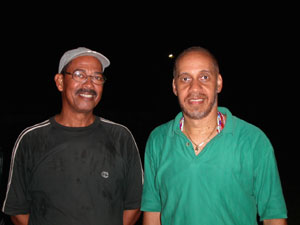
Gérard Pomer (à gauche) et Neil Clarke (à droite) à l'Artchipel (Basse-Terre) en décembre 2002.
© Médiathèque Caraïbe (Laméca)
A présent si ces gens continuent à jouer ou danser, ils font du mieux qu'ils peuvent. Les enfants qui les regardent vont voir ça, et ils vont penser que c'est comme cela qu'on doit faire. Et quand les plus vieux seront partis, qui sait, et que des jeunes vont le faire d'une façon dont personne ne leur a dit que ce n'est pas la bonne, alors cela va disparaître.
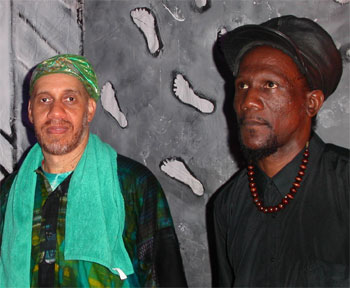
Neil Clarke (à gauche) et Léon Leborgne (à droite), percussionniste du groupe de Kafé, à l'Artchipel (Basse-Terre) en décembre 2002.
© Médiathèque Caraïbe (Laméca)
Le marqueur marque le danseur, alors quand le marqueur marque le danseur qui fait des choses inappropriées, c'est tout le langage du marqueur qui change.
Et la tradition que nous voyons aujourd'hui ne sera plus la tradition. Cela ne pose pas de problème parce que vous avez droit à la créativité, mais la créativité doit être basé sur la connaissance.
Traditionnellement, la danse c'est la langue. Alors peut-être qu'il y a quelque chose dans les mouvements du woulé d'avant qui parle de ce qu'on faisait quand on travaillait dans les champs.
Peut-être que les anciens vous diraient que vous faites un mouvement de padjanbel en dansant le graj alors que vous ne devriez pas. Mais si vous ne savez pas, vous dansez et vous ne connaissez pas les mouvements du padjanbel, vous faites des mouvements appropriés au graj, et le marqueur les joue, et tout le monde fait de même, et la tradition est partie.
Nous parlions l'autre jour de la rumba ; de la rumba yambu et de la rumba guaguanco. Le yambu est un très vieux genre de rumba, et sa caractéristique est qu'elle est très lente, parce que c'est la sensibilité des gens de la campagne. La rumba guaguanco est plus moderne et plus rapide. On constate généralement que la musique des gens de la campagne est plus lente et de tonalité plus basse que la musique de la ville, plus rapide et d'une tonalité plus élevée. Cela dépend de l'environnement des gens. Les gens de la ville ont l'habitude d'entendre des tonalités élevées et des cadences rapides. Si on joue plus lentement et dans une tonalité plus basse, ils s'ennuient, on n'arrive pas à conserver leur attention. Si on joue de la musique rapide et ans une tonalité élevée à des gens de la campagne, après un moment, ils trouvent ça trop. La musique reflète l'environnement d'où les gens viennent.
Si on a l'occasion d'étudier l'histoire des différents rythmes du gwoka, peut-être qu'on va voir quelque chose sur leurs origines et les idées qui y sont exprimées.
Je suis désolé de n'avoir que deux semaines ici, et j'aurais vraiment aimé avoir l'occasion de rester plus. Il faudrait que je trouve un moyen de revenir. C'est très intéressant pour moi, en particulier avec l'idée qu'il existe un rythme qui s'appelle mendé, et qu'il y a un possibilité qu'il se rattache au peuple Mende au Sierra Leone. Il y a une possibilité que des esclaves du Sierra Leone aient été amené ici, et que le rythme que vous appelez mendé est un rythme que jouait ces gens. Je trouve cela très intéressant.
Il faudrait aussi chercher sur les autres rythmes. Peut-être qu'ils sont rattaché à quelque chose. Comme le tambour conga ; conga, congo. En kikongo, "conga" veut dire "appeler". Cela donne des éléments. Est-ce que c'est une conga parce que c'est joué par des gens venant du Congo, ou est-ce que c'est une conga parce que les gens du Congo s'en servaient pour appeler ? Cela donne des étapes de réflexions, des éléments auxquels s'accrocher...
Dans la dernière ou dans les deux dernières décennies, il y a eu une explosion global de l'intérêt dans les percussions africaines, sous toutes leurs formes. Et quand je dis percussions africaines, j'y inclus Cuba, le djembé, la samba...que je considère toutes comme percussions africaines. Il y a eu une incroyable explosion d'intérêt. Il y a 30 ans, les gens considéraient les percussions comme primitif, inférieur et insignifiant.
Aujourd'hui il des gens dans le monde entier, en Europe, dans toute l'Europe, dans tous les Etats-Unis, au Canada... des gens qui ne sont pas d'ascendance africaine et qui deviennent fous.
Je blague, mais j'ai peur que tous les arbres en Afrique soit coupés pour alimenter cette folie. Avant chaque tambour était fait d'une façon particulière, d'un bois particulier, d'un arbre particulier, à un moment particulier. Aujourd'hui c'est une production de masse qui alimente une frénésie commerciale, destinée à des gens qui jouent des percussions le week-end, et les tambours sont là, ils sont joués pendant 6 mois et puis plus jamais.
En même temps, il y a vraiment un intérêt massif. Mais les gens l'approchent à un niveau tellement superficiel.
Si je voulais apprendre le violon, j'irais voir un professeur, j'apprendrais la technique, et le répertoire que j'apprendrais serait issu des compositeurs et des maîtres reconnus de la musique classique. C'est comme cela que je me formerais. Et il y aurait une façon appropriée de faire, et une façon inappropriée de faire. Et si j'avais un bon professeur, un professeur qui s'assure que je sache, même si c'est sa propre interprétation, ce serait la façon appropriée de jouer.
Je pense que très peu de gens ont un violon et apprennent par eux-mêmes. Mais ceux qui se mettent aux percussions, ils apprennent par eux-mêmes, et vont jouer en public sans avoir étudié avec quelqu'un qui sait vraiment.
Mais, encore une fois, il y a un tel engouement pour les percussions africaines. Et je pense que le gwoka doit faire partie de cet examen, parce que c'est un élément de l'histoire, un élément du tableau.
Pour moi, enfin, si la signification et la prospective particulière des rythmes, de la sensibilité et de la vie se perdent, alors nous avons tous perdu. Comme si nous étions des peintres et que tout d'un coup le bleu n'était plus disponible. Comment peut-on peindre un tableau avec le ciel ou l'océan sans bleu. Ou si le rouge n'est plus disponible, ou si le jaune n'est plus disponible...
C'est ce que je ressens à partir de mon expérience de l'étude du rythme et de l'étude des percussions traditionnelles.
Si on ne comprend pas la substance et si on n'a ni la substance ni l'inspiration des différents rythmes, ou si cela ne vous est pas disponible, si cela disparaît, il manque une couleur.
C'est passionnant pour moi de venir en Guadeloupe et d'écouter du gwoka, et d'essayer d'en saisir l'esprit. Moi, je peux jouer la rumba, je peux jouer le djembé, je peux jouer le cutillo, je peux jouer le merengue, je peux jouer la bomba et la plena... mais le gwoka a une personnalité particulière qui est superbe, au même titre que n'importe quel autre. Et cela existe, c'est vivant. Et des gens le vivent du moment où ils naissent jusqu'au moment où il meurent. Vélo, les maîtres... Les gens vont au léwòz... c'est un art de vie, ah c'est incroyable, incroyable !
Interview originale en anglais
For me, with the gwoka, before I came here I had no idea. Maybe if I had seen the CD with David Murray or something, then I would know something about it.
I didn't know anything about gwoka, anf I actually didn't even know the name before I arrived here, and when I asked Luc [Michaux-Vignes] about what is the traditionnal music here.
I looked on the internet for information about the traditionnal culture of Guadeloupe, and I got things, information on Guadeloupe and also Martinique, I saw information about zouk, I saw information maybe about biguine, nothing about gwoka.
Maybe my search was not deep enough or broad enough but I'm more than the average tourist. If I didn't find it, I think it would be difficult for the average tourist to find it because there's nothing there.
So, when I arrived, Luc [Michaux-Vignes] told me about gwoka, he told me the traditionnal drums, he gave me some explanation, but I had no idea what it was.
As I began to find out about gwoka, the first thing I understood was that it was a style of music. The style of music got its name or was related with the gwoka drum. So I know gwoka drums, I know gwoka music, I had no more idea.
And even the first exposure that I had to the gwoka was the demonstration That Kafé did.
Kafé explained the seven rythms, and he did the boula, he showed the boula. But his demonstration didn't give the marqueur. His demonstration didn't include the song ; his demonstration didn't include the dance. So, for me, it's incomplete.
Now, again, because I'm interested, because I'm a percussionist, because I have been doing research for 30 years, I recognised that it was incomplete.
If you have people from Guadeloupe who are demonstrating gwoka, and all they give you is the boula rhythm, then you think it's all there is to it. So you really don't have an idea of what the complexity and the depth of the tradition is, because you're not getting all of the part. That's like saying jazz is just [he sings a basic rhythm], and nothing else.
You know, you need the base, you need the chord structure. All of that is what jazz is.
To really get an idea, say, the average person who comes to Guadeloupe may not be interested in the gwoka "folklorique", the gwoka "traditionnel".
But they may be interested in "gwoka moderne". But in order to really understand "gwoka moderne", it would be nice to have an understanding of "gwoka traditionnel", so you can see where it comes from.
As I began to become more aware of what the gwoka was, it amazes me, it really really amazes me at the depth of this tradition with the drumming, with the dancing, with the songs, with the structure of the melody, with the interaction beetween the dance and the marqueur...
For there to be a tradition that is so deep, and for me not to know about it ! Percussionists know about bomba, they know about plena, they know about samba, they know about battucada, they know about merengue... they know about all these different rhythms in the Caribbean, and gwoka is a big secret, it's a big mystery. Not even a mystery, cause maybe you know about gwoka but you don't know anything about it, then at least you know that there is something to find out about.
I had to find out these 7 rhythms, these 9 rhythms, with different names, some of the names reflecting names from Africa. I've studied west-african drumming, many different kinds of drum orchestras and styles and traditions from Mali, from Guinea, from Senegal, from Nigeria, from Ghana, from Ivory Cost.
So when I see that, wahh, there's something in Guadeloupe where you have a specific kind of drum that's made a specific kind of way, is played in a specific technique, there are specific notes, there is a specific way that it's played in relation to the dancer, there is a specific interaction beetween the drum and the dance, there are recognised masters, there are different styles from different region of the island... That says to me that is something really significant. It's not just something that people get together and they play whatever they feel like playing.
There are masters, there are styles, there are traditions. That says to me it is a whole line. And I think a majority of people don't get an opportunity to understand it on that level. I think the only reason that I am beginning to understand it on that level in the fiteen days that I've been here is, number one, because I've had an experience before of studying and doing research in the drum traditions.
And number two, I'm taking the initiative, I'm taking the motivation to go and look for it and ask the questions to find out.
Because even the people in the group that I'm with [African Project], they don't understand the way that I understand it because they have not taken the time to go look for it and they haven't asked the questions.
I feel that I have only touched the surface, because what I think about gwoka beeing the traditionnal music of Guadeloupe, it's an expressin of the life, of the history, of the tradition, of the sentiment. All these things, the way they dance, the phrases... because the phrasing I know from Africa. Very often when you study african traditionnal drumming, and variations of styles, very often there is a direct relationship beetween the spoken language and the cadence of the way the phrases are played on the drum. If you listen to traditionnal african drumming from a particular region and you make comparisons in a variation, very often there's a direct relationship beetween the cadence and the way the people speak, and the rhythm, the rhythmic structure of the phrases, and very often the drum acts as a surogate of speech, as in bata. Traditionnaly in bata, it is speaking phrases.
If you talk to djembe players from certain parts of Guinea, from certain parts of Mali, from certain parts of Ivory Coast, they are talking when they play the phrases they are talking. So in the way of the flow, in the way of the cadence, the way they speak, will reflect the way that they play ; the way that they play will reflect the way that they speak.
That's why very often if you want to play rumba, if you don't know how to speak spanish, and if you don't understand the way the people speak, you're not gonna really understand the phrase.
And from that night we went lewoz, and I was playing together with Ti bonm-la [Joseph Kancel], he was playing, I understood everything that he was playing, but to me to find a way to play the way he was playing, I have to think in creole. Because the way that you play is creole, and the way that I play is Brooklyn.
I can play like that, but it would take time. An if I learn to speak creole, and I learn the attitude, and I learn the sentiment, and the feeling, then I can play the marqueur. I have no doubt. As they say, if you want to speak a language, you get a girl friend from that country, because you learn its organic.
As Georges Troupé was saying, To understand is to study it scientifically. To do it, you have to do it organically. You have to do it because you feel it. A professor can write on the board, like the score that you have, or the website, or the different gwoka rhythms, any music studied ; anyone who read music can understand what that is. That doesn't mean that they can play it. Because you have to feel it to play it.
You see people they study and they understand, they play it, but it's not alive. In order to be alive, you have to fell it, you have to experience it.
So for me, with the gwoka, I am beginning, I am in the process of beginning. And that's why it was important for me to start with gwoka "traditionnel", to start with lewoz, because it's the root. It's where everything else is coming from.
Gwoka "moderne", into the zouk, it started with lewoz. It started with pajanbel, mende, graj, tumblak... So in order for me to understand now, as I build an understanding of the music of the boula, the music of lewoz, now if I am moving to the gwoka modern, I'll understand where it's coming from. Because sometimes the base is playing the boula, but if I don't know that the base is playing the boula, then I think it's just a baseline, and now I can take liberty of improvisation, not knowing that it has to be together with, in the same way that in the cuban music with the clave and with the tumbao. Because in cuban music, what the base is playing is really coming from tumbao. So now people hear the base and say oh yeah, it's awesome. But they don't realize it's coming from the drum, it's coming from tumbao.
So you build your understanding from the ground up. And the more time that I spend, I have a feeling, I talked with Bébé [Pierre-Jean Rospart], I talked with Gérard [Pomer], I talked with Ti bonm-la [Joseph Kancel], different styles, different flavours... I'm sure if I had time I would have understand it.
Now that I have the opportunity, my next step would be to listen to gwoka moderne, which I haven't started to do yet. So I can't even say what is the expression in Guadeloupe popular music, because I haven't moved to that stage. I can appreciate it, I can enjoy it, but to understand it as a musician to be able to play it, first I have to understand.
With the gwoka, it's also amazing me that there's not more understanding of the significance of the rhythms, and the origins of the rhythms. It's really amazing to me that the rhytms have survived, as specifically as they have survived without having more significance attached to them : a specific order or cultural signifiance...
Because obviously traditionnaly in Africa rhythms were used for specific purposes : work rhythms, praise rhythms, celebration rhythms. Religious rhythms...
I just find it very intersting that the body of rhythmic material has survived without its specific significance for the different rhythms, that purpose for the rhythms.
I think it's important because when we saw the class that Bébé [Pierre-Jean Rospart] was teaching, Bébé was explaining to the dancers that there are certain movement that are appropriate and acceptable, and certain movements that are not appropriate and not acceptable. One of the things he said was that women don't lift their legs up very high. And an other thing he said is that your knees don't touch the ground. And an other thing he said is that there is no break in the movement.
Now, what happens is that if people don't understand the story, there is no reason for them not to do inappropriate things.
So, if as the generations go by, and nobody understand the story to keep them from doing inappropriate things, then the tradition is going to disapear. As we talked with Gérard [Pomer] and I asked Gérard what he thought about that, nad I asked Gérard because I remembered what Bébé said about doing things which were not appropriate. And Gérard responded they do the best they can, which to me was a very diplomatic way of saying they really don't know, so they can't be expected to do it properly, because they don't know.
Now, if these people continue to do it, they do the best they can. The children which are watching them are gonna see it, and the children gonna think it's OK. And when the old people are gone, who know, and the new people are doing it in a way that nobody said that it is not the proper way, then it' gonna go. Because there's nobody keeping it. Because there what happens is as the dancer's dance is inappropriate, the marqueur marks the dancers. So as the marqueur marks the dancers dancing inappropriate, now the whole language of the marqueur changes.
So the tradition that we see now it's not going to be the tradition, which is Ok because yo have creativity, but creativity should be based on an understanding. Because traditionnally the dance is a language.
So maybe there's something in the movements of woulé before that talked about what you do when you're working in the fields.
Maybe the old people would tell you that you're doing a movement for pajanbel inside graj, and you are not supposed to do it here. But if you don't know, people dance and they don't know the movements for pajanbel, and they make a movement appropriate for graj, and the marqueur plays it, and everybody is doing it like that, and the tradition is gone...
We were talking about rumba the other day, about rumba yanbu and rumba guaguanco, and the yanbu is a very old style of rumba. And characteristically, rumba yambu is very slow, because it is the feeling of people in the country. Rumba guaguanco is more modern, and is faster, and you find normally music of people of the country is slower and is of a lower tonality than music in the city which is faster and higher. And it's because of the environment of the people. People who are in the city, and are used to hear high pitch and fast, if you play low pitch and slow, they get bored. It lacks keeping their attention. If you play music that is fast and high pitch for people of the country, after a while they get... it's too much. Music reflects the environment the people come in.
So I think if you have opportunity to study the history of the different rhythms in gwoka, maybe you're gonna see something about the origin and the idea being expressed.
I'm sorry that I only have 2 weeks here, and I really wish that I had more opportunity to stay ; I have to find a way to come back sometime. It's very interesting to me. And especially with the idea it is a rhythm called mendé, and it's so clear that the possibility exists that it's related to the mende people in Siera Leone.
Now the thing would be to find out what of the other rhythms. Maybe they reflect something. Because the conga drum, conga, congo. In kikango, conga means to call. So now you have some keys on how to look at it. Is it a congo drum because it is played by the people from the Congo, or it is the conga drum because the congo people used it to call ? It gives you some steps, some things to grab... [...]
I'm very excited about the gwoka. I'm excited about the Médiathèque [Caraïbe] because a place that is dedicated to exploring and making available the information about these different traditions, so it creates a forum when people who are interested can come to open up the understanding. It's an example I believe for many other places in the world.
In the last decades or two decades, there has been a global explosion of interest in african drumming, in any kind of form. And when I say african drumming, I include cuban, djembe, samba, all of them I consider african drumming. There has been an incredible explosion of interest. People, three decades ago, looked at drumming as primitive and inferior and insignificant. Now you find people all over the world, in Europe, all over Europe, all over the United-States, Canada... people who are not of african ancestry, are going crazy. I make a joke but I am afraid that all the trees in Africa are going to be cut down to feed this madness for drums. When the drums were cut down in very special way, and which wood... special drum, special tree, special time to make a drum. Now it's being mass produced in such a commercial frenzy. For people who want to play drums in the week-end, and the drums sit there, and they're palyed for 6 months and never played again.
Meantime, there's such a mass interest. But people are approaching it on such a superficial level. If I was interested in playing violin, and I want to learn from a teacher, I would be learning the technique and then the repertoire that I would learn wopuld be aknowledged pieces by aknowledged composers and masters of classical music... And this is how I would get my training. And there would be an appropriate way to do it and an inappropriate way to do it. And if I had a quality teacher, a teacher that'd make sure that I knew, even if that was the teacher's interpretation, it would be the proper way to play this.
Very few people, I think, have violins and just go and teach themselves. But people who take drums, they teach themselves, and will go out and play in public not having studied with anyone that really knows.
But, again, there is such an interest in african drumming... toward Brazil, djembe, bata... And I think the gwoka need to be inside of that whole examination, because it is a piece of the story, a piece of the picture.
But to me in the end, if the significance and the particular prospective on rhytm and on sensibility and on life, if it gets lost, we all have lost. As if we were all painters, and all of a sudden blue was no longer available. How can you paint a picture why a sky or the ocean if you have no blue. Or red is not available, or yellow is not available... That's the way that I feel from my experience of studying rhythm and studying drum traditions. If you don't undertand the substance and if you don't have the substance and the inspiration of the different rhythms, if you don't have it available to you, if it disappears, we're missing a color.
It's exciting to me to come to Guadeloupe and to listen to the gwoka and to experience it, to try to catch the spirit of gwoka. Me I can play rumba, I can play Djembe, I can play cutillo, I can play merengue, I can play bomba plena... but gwoka has a particular personnality which is nice, as something else. And it exists, it's alive, and people live from when they're born to when they die. Vélo, the masters... People go to lewoz, it's a way of life, ah, incredible, incredible !
______________________________________
© Médiathèque Caraïbe / Conseil Départemental de la Guadeloupe, décembre 2002 - juillet 2022

